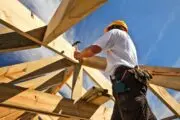From its construction in the early 1960s to the very end of the 20th century, we take a historic look back at Seattle’s most iconic structure.
ca. 1961

The original plan for the Space Needle was a tower with a spherical top, which was drawn on a placemat in a coffee shop by entrepreneur Edward E. Carlson. This initial, preliminary design was envisioned just three years before construction wrapped up on the famed tower.
ca. 1961

Finding the Space Needle’s location was no easy feat. After a long search, the project leaders finally purchased a 120-foot by 120-foot plot near Broad Street for $75,000.
ca. 1961

Once the land was acquired, construction had to move quickly to ensure that the tower was ready for the World’s Fair, which was to take place just one year later. The fair’s theme was 21st century, and the modular, flying saucer-topped Space Needle was to be the main event.
1962

The Space Needle was completed in December 1961 at a cost of $4.5 million. The space-age theme was carried through all the way to the paint colors with Astronaut White for the legs, Re-entry Red for the halo, Orbital Olive for the core and Galaxy Gold for the sunburst and roof.
ca. 1962

The tower opened to the public on April 21st, 1962 — the first day of the World’s Fair. During the several months that the fair was in Seattle, 2.3 million visitors explored the landmark and almost 20,000 people took the elevators all the way to the top.
ca. 1962

The entire Space Needle structure measures 605 feet with retail shopping at ground level, a banquet facility 100 feet up, the revolving SkyCity restaurant 500 feet up and an observation deck at 520 feet. Ironically, the building’s first manager, Hoge Sullivan, was deathly afraid of heights.
ca. 1962

Although it might look spindly, the Space Needle was built to stand strong and sturdy in the face of storms and earthquakes — neither a 1993 storm with 90 mile-per-hour wind nor an earthquake in 2001, which measured 6.8 on the Richter Scale, could shake the tower.
ca. 1968

The Space Needle’s foundation is made of 5,850 tons of steel and concrete and its center of gravity is just five feet from ground level. The foundation had to be dug 30 feet deep to ensure the tall, narrow structure’s stability, and it took 467 cement trucks less than 12 hours to fill the massive pit.
ca. 1970

The Space Needle’s restaurant, SkyCity, measures 94.5 feet in diameter and revolves on a 125-ton system with a 1.5 horsepower motor. The restaurant was named restaurant of the year by Washington Wine Commission in 2009 and “Best View” by Where Magazine’s Visitors Choice Dining Awards.
ca. 1978

Each elevator in the Space Needle weighs about 14,000 pounds and can hold a maximum of 4,500 pounds, or roughly 25 people. But don’t worry about plummeting to the ground if the seven cables snap unexpectedly — a governor brake would lock the elevator in place should the worst happen.
ca. 1985

On April Fool’s Day, 1989, a local sketch comedy show called Almost Live reported that the Space Needle had toppled over, sending residents of the city and their relatives from out of town into a frenzy and causing the emergency phone lines to be inundated with panicked calls. Throughout the report, a graphic notified the viewers that it was a prank, but some people just didn’t get the hint!
ca. 1985

The actual needle weighs a whopping 3,700 tons. To keep it steady and secure, the foundation contains 250 tons of reinforcing steel and 72 30-foot bolts fasten it to the ground.
ca. 1985

The Space Needle has its own Instagram account with over 15,000 followers. Follow along with @spaceneedle to see updates on Seattle’s most-visited tourist attraction.
ca. 1991

New elevators were installed in the Space Needle in 1993 at a cost of $1.5 million. Today, two of the building’s elevators are high speed, which fall as fast as a raindrop and even faster than a snowflake, so the snow will appear to be falling up instead of down to the passengers.
ca. 1999

In 2000, the Space Needle underwent a comprehensive makeover, costing a cool $20 million. The revitalization took a year to complete and included the addition of the SkyCity restaurant, a retail store, a couple of new coats of paint and more.






